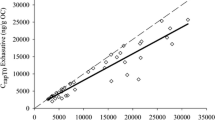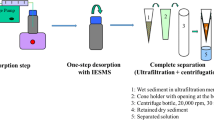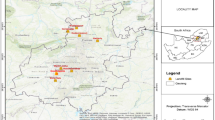Abstract
Purpose
Dechlorane plus and its related compounds (DPs) are halogenated flame retardants. DP residues were widely detected in sediment because of its high hydrophobicity and extensive use in the electronics industry. In this study, Tenax extraction, a well-established method, was used to measure the effects of total organic carbon (TOC) content in sediment, aging time, and temperature on desorption behavior of DPs from sediment. Consequently, the bioavailability was estimated.
Materials and methods
Three sediments (S1, S2, S3) with different TOC contents and particle-size distributions were collected from several different rivers and reservoirs in China. The sediments were spiked with a mix of DPs and extracted with Tenax resin. Desorption kinetics of DPs was obtained by measuring the amount of DPs that Tenax absorbed from sediments at 20 time points (1, 2, 3, 4, 6, 8, 10, 12, 24, 48, 72, 96, 144, 192, 240, 360, 480, 648, 816, or 1080 h). Then, the sediment (S1) with the highest TOC content was selected to study the effects of aging (14 days and 60 days) and temperature (30 °C and 50 °C).
Results and discussion
Desorption kinetics were well described by a first-order three-compartment model. The content of TOC has different effects on the desorption of DPs. Desorption rates of dechlorane 602 (Dec 602) and Dec 604 decreased with the increase in TOC contents, while those of syn-DP and anti-DP were the largest in S2, which has an intermediate TOC content. The desorption of Dec 603 in S1 and S2 were similar, which may be attributed to similar contents of clay and silt in those two sediments. With the decreasing temperature and increasing aging time, the rapid fractions (Frap) of DP, Dec 602, Dec 603, and Dec 604 decreased. The desorption of decachloropentacyclooctadecadiene (anti-Cl10-DP) and undecachloropentacyclooctadecadiene (anti-Cl11-DP) was unaffected by TOC contents, aging time, and temperature.
Conclusions
The contents of TOC have different effects on desorption of DPs. After aging, DPs release from sediment more slowly, and high temperatures will speed up this process. According to Frap and t99.9 values, DP is a group of halogenated flame retardants with low bioavailability, and Dec 602 has the highest bioavailability for biota among DPs.



Similar content being viewed by others
References
Cornelissen G, van Noort PCM, Govers HAJ (1997) Desorption kinetics of chlorobenzenes, polycyclic aromatic hydrocarbons, and polychlorinated biphenyls: sediment extraction with Tenax®; and effects of contact time and solute hydrophobicity. Environ Toxicol Chem 16(7):1351–1357
Crawford SE, Liber K (2016) Sediment properties influencing the bioavailability of uranium to Chironomus dilutus larvae in spiked field sediments. Chemosphere 148:77–85
De Weert J, De La Cal A, Van Den Berg H, Murk A, Langenhoff A, Rijnaart H, Grotenhuis T (2008) Bioavailability and biodegradation of nonylphenol in sediment determined with chemical and bioanalysis. Environ Toxicol Chem 27(4):778–785
Duan L, Palanisami T, Liu Y, Dong Z, Mallavarapu M, Kuchel T, Semple KT, Naidu R (2014) Effects of ageing and soil properties on the oral bioavailability of benzo[a]pyrene using a swine model. Environ Int 70:192–202
Gong YY, Depinto JV, Rhee GY, Liu X (1998) Desorption rates of two PCB congeners from suspended sediments---I. experimental results. Water Res 32(8):2507–2517
Greenberg MS, Burton GA, Landrum PF, Leppänen MT, Kukkonen JVK (2005) Desorption kinetics of fluoranthene and trifluralin from Lake Huron and Lake Erie, USA, sediments. Environ Toxicol Chem 24(1):31–39
Hoh E, Zhu L, Hites RA (2006) Dechlorane plus, a chlorinated flame retardant, in the Great Lakes. Environ Sci Technol 40(4):1184–1189
Jia HL, Sun YQ, Liu XJ, Yang M, Wang DG, Qi H, Shen L, Sverko E, Reiner E, Li YF (2011) Concentration and bioaccumulation of dechlorane compounds in coastal environment of northern China. Environ Sci Technol 45(7):2613–2618
Kang JH, Kim JC, Jin GZ, Park H, Baek SY, Chang YS (2010) Detection of dechlorane plus in fish from urban-industrial rivers. Chemosphere 79(8):850–854
Kang H, Moon HB, Choi K (2016) Toxicological responses following short-term exposure through gavage feeding or water-borne exposure to dechlorane plus in zebrafish (Danio rerio). Chemosphere 146:226–232
Kraaij RH, Tolls J, Sijm D, Cornelissen G, Heikens A, Belfroid A (2002) Effects of contact time on the sequestration and bioavailability of different classes of hydrophobic organic chemicals to benthic oligochaetes (Tubificidae). Environ Toxicol Chem 21(4):752–759
Kukkonen JVK, Landrum PF, Mitra S, Gossiaux DC, Gunnarsson J, Weston D (2004) The role of desorption for describing the bioavailability of select polycyclic aromatic hydrocarbon and polychlorinated biphenyl congeners for seven laboratory-spiked sediments. Environ Toxicol Chem 23(8):1842–1851
Leppänen MT, Landrum PF, Kukkonen JV, Greenberg MS, Jr BG, Robinson SD, Gossiaux C (2003) Investigating the role of desorption on the bioavailability of sediment-associated 3,4,3′,4′-tetrachlorobiphenyl in benthic invertebrates. Environ Toxicol Chem 22(12):2861–2871
Liang XF, Li W, Martyniuk CJ, Zha JM, Wang ZJ, Cheng G, Giesy JP (2014) Effects of dechlorane plus on the hepatic proteome of juvenile Chinese sturgeon (Acipenser sinensis). Aquat Toxicol 148:83–91
Liu M, Tian SY, Chen P, Zhu LY (2011) Predicting the bioavailability of sediment-associated polybrominated diphenyl ethers using a 45-d sequential Tenax extraction. Chemosphere 85(3):424–431
Lydy MJ, Harwood AD, Nutile SA, Landrum PF (2015) Tenax extraction of sediments to estimate desorption and bioavailability of hydrophobic contaminants: a literature review. Integr Environ Asses 11(2):208–220
Moller A, Xie ZY, Sturm R, Ebinghaus R (2010) Large-scale distribution of dechlorane plus in air and seawater from the Arctic to Antarctica. Environ Sci Technol 44(23):8977–8982
Pignatello JJ, Xing BS (1996) Mechanisms of slow sorption of organic chemicals to natural particles. Environ Sci Technol 30(1):1–11
Qi Y, Zhang TC, Ren Y (2014) Testosterone sorption and desorption: effects of soil particle size. J Hazard Mater 279:493–501
Ren N, Ed S, Li YF, Zhang Z, Harner T, Wang DG, Xinnan W, Mccarry BE (2008) Levels and isomer profiles of dechlorane plus in Chinese air. Environ Sci Technol 42(17):6476–6480
Rjabova J, Bartkevics V, Zacs D (2016) The occurrence of dechlorane plus and related norbornene-based flame retardants in Baltic wild salmon (Salmo salar). Chemosphere 147:210–217
Shen L, Reiner EJ, Macpherson KA, Koli TM, Sverko E, Helm PA, Bhavsar SP, Brindle LD, Marvin CH (2010) Identification and screening analysis of halogenated norbornene flame retardants in the Laurentian Great Lakes: dechloranes 602, 603, and 604. Environ Sci Technol 44(2):760–766
Shen L, Reiner EJ, Helm PA, Marvin CH, Hill B, Zhang XM, MacPherson KA, Kolic TM, Tomy GT, Brindle ID (2011) Historic trends of dechloranes 602, 603, 604, dechlorane plus and other norbornene derivatives and their bioaccumulation potential in Lake Ontario. Environ Sci Technol 45(8):3333–3340
Sinche FL, Nutile SA, Landrum P, Lydy MJ (2017) Optimization of Tenax extraction parameters for polychlorinated biphenyls in contaminated sediments. TALANTA 164:386–395
Sinche FL, Nutile SA, Hartz KEH, Landrum PF, Lydy MJ (2018) Effects of type and quantity of organic carbon on the bioaccessibility polychlorinated biphenys in contaminated sediments. Environ Toxicol Chem 37(5):1280–1290
Song Y, Wang F, Yang X, Liu C, Kengara FO, Jin X, Jiang X (2011) Chemical extraction to assess the bioavailability of chlorobenzenes in soil with different aging periods. J Soils Sediments 11(8):1345–1354
Sormunen AJ, Leppänen MT, Kukkonen JVK (2009) Examining the role of temperature and sediment-chemical contact time on desorption and bioavailability of sediment-associated tetrabromo diphenyl ether and benzo(a)pyrene. Ecotox Environ Safe 72(4):1234–1241
Sormunen AJ, Tuikka AI, Akkanen J, Leppänen MT, Kukkonen JVK (2010) Predicting the bioavailability of sediment-associated spiked compounds by using the polyoxymethylene passive sampling and Tenax ® extraction methods in sediments from three river basins in Europe. Arch Environ Contam Toxicol 59(1):80–90
Sun MM, Ye M, Hu F, Li HX, Teng Y, Luo YM, Jiang X, Kengara FO (2014) Tenax extraction for exploring rate-limiting factors in methyl-beta-cyclodextrin enhanced anaerobic biodegradation of PAHs under denitrifying conditions in a red paddy soil. J Hazard Mater 264:505–513
Sverko E, Tomy GT, Marvin CH, Zaruk D, Reiner E, Helm PA, Hill B, Mccarry BE (2008) Dechlorane plus levels in sediment of the lower Great Lakes. Environ Sci Technol 42(2):361–366
Ten Hulscher TEM, Cornelissen G (1996) Effect of temperature on sorption equilibrium and sorption kinetics of organic micropollutants - a review. Chemosphere 32(4):609–626
Ten Hulscher TEM, Vrind BA, Van Noort PCM, Govers HA (2004) Temperature effects on very slow desorption of native chlorobenzenes from sediment to water. Environ Toxicol Chem 23(7):1634–1639
Tomy GT, Pleskach K, Ismail N, Whittle DM, Helm PA, Sverko E, Zaruk D, Marvin CH (2007) Isomers of dechlorane plus in Lake Winnipeg and Lake Ontario food webs. Environ Sci Technol 41(7):2249–2254
Tomy GT, Thomas CR, Zidane TM, Murison KE, Pleskach K, Hare J, Arsenault G, Marvin CH, Sverko E (2008) Examination of isomer specific bioaccumulation parameters and potential in vivo hepatic metabolites of syn- and anti-dechlorane plus isomers in juvenile rainbow trout (Oncorhynchus mykiss). Environ Sci Technol 42(15):5562–5567
Venier M, Hites RA (2008) Flame retardants in the atmosphere near the Great Lakes. Environ Sci Technol 42(13):4745–4751
Wang XL, Xing BS (2007) Importance of structural makeup of biopolymers for organic contaminant sorption. Environ Sci Technol 41(10):3559–3565
Wang P, Zhang QH, Zhang HD, Wang T, Sun HZ, Zheng SC, Li YM, Liang Y, Jiang GB (2016) Sources and environmental behaviors of dechlorane plus and related compounds - a review. Environ Int 88:206–220
Xian QM, Siddique S, Li T, Feng YL, Takser L, Zhu JP (2011) Sources and environmental behavior of dechlorane plus--a review. Environ Int 37(7):1273–1284
Xu YP, Gan J, Wang ZJ, Spurlock F (2008) Effect of aging on desorption kinetics of sediment-associated pyrethroids. Environ Toxicol Chem 27(6):1293–1301
Yang XL, Wang F, Gu CG, Jiang X (2010) Tenax TA extraction to assess the bioavailability of DDTs in cotton field soils. J Hazard Mater 179(1–3):676–683
Yang XL, Lv ZY, Bian YR, Wang F, Gu CG, Song Y, Jiang X (2013) Predicting PAHs bioavailability for earthworms by mild solvents and Tenax extraction. J Environ Chem Eng 1(4):768–776
Yu D, Yang J, Li T, Feng JF, Xian QM, Zhu JP (2015) Levels and distribution of dechloranes in sediments of Lake Taihu, China. Environ Sci Pollut Res 22(9):6601–6609
Zhang Y, Wu J, Luo X, Sun Y, Mo L (2011) Biota-sediment accumulation factors for dechlorane plus in bottom fish from an electronic waste recycling site, South Cina. Environ Int 37(8):1357–1361
Zhang J, You J, Li HZ, Mehler WT, Zeng EY (2018) Particle-scale understanding of cypermethrin in sediment: desorption, bioavailability, and bioaccumulation in benthic invertebrate Lumbriculus variegatus. Sci Total Environ 642:638–645
Funding
This research was supported by the National Natural Science Foundation of China (Nos. 41877494 and 21407038) and the Natural Science Foundation of Zhejiang Province (Nos. LY18B070012 and LY18B070008).
Author information
Authors and Affiliations
Corresponding author
Additional information
Responsible editor: Henner Hollert
Publisher’s note
Springer Nature remains neutral with regard to jurisdictional claims in published maps and institutional affiliations.
Rights and permissions
About this article
Cite this article
Zhou, S., Zhou, Y., Zhu, H. et al. Assessing desorption behavior of dechlorane plus and related compounds from laboratory-spiked sediment using Tenax extraction. J Soils Sediments 19, 3847–3855 (2019). https://doi.org/10.1007/s11368-019-02335-1
Received:
Accepted:
Published:
Issue Date:
DOI: https://doi.org/10.1007/s11368-019-02335-1




